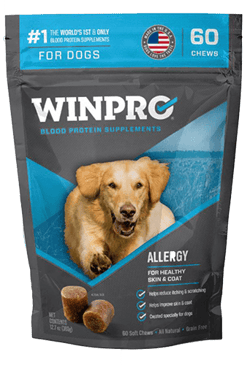 What is Atopic Dermatitis?
What is Atopic Dermatitis?
Atopic dermatitis, often called “environmental allergies,” is one of the most common causes of chronic itching in dogs. It is caused by an allergic reaction (hypersensitivity) to one or more substances in the environment.
In atopic dermatitis, various substances, called allergens, can serve as the trigger for this allergic reaction. They are often, though not always, the same allergens implicated in human allergic conditions such as hayfever and asthma. And allergens in foods can trigger a nearly identical pattern of signs in the dog.
What Are the Signs of Atopic Dermatitis?
Dogs with atopic dermatitis are usually itchy, with their face and/or feet seeming particularly irritated. The skin on some parts of the body may be reddened, moist, or damaged due to scratching or chewing. The ears may also be inflamed, and recurrent ear infections are quite common in patients with atopic dermatitis. Skin infections can also occur. Less often, dogs with atopic dermatitis have other signs of “allergies” including runny eyes or nose. The signs usually start when a dog is 1 to 5 years old. Unlike many people, dogs do not “grow out” of their allergies – so treatment is almost always recommended.
Why Does Atopic Dermatitis Develop?
A combination of factors predisposes dogs to atopic dermatitis. Both their genetic make-up and environment may interact to allow atopic dermatitis to develop. The condition is caused by an inappropriate immune reaction to the allergens, rather than by the allergens themselves.
How are dogs exposed to allergens?
Many allergens are airborne and found nearly everywhere. Some are present year-round (such as house dust, dust mites, and some molds) while others are found at high levels only at some times during the year (such as pollens). Atopic dermatitis in dogs is caused primarily by exposure to these allergens through the skin, but breathing them in can also result in signs.

How Is Atopic Dermatitis Diagnosed?
The diagnosis is based on your observations of your pet and on your veterinarian’s physical examination, as well as by ruling out other causes of allergies, primarily parasites and food.Can my dog be tested for allergies to find out what they are allergic to?
While there are allergen tests used on dogs with atopic dermatitis, such allergy testing is used by veterinarians for the purpose of formulating an allergy vaccine, not to make the diagnosis. There are two general methods to perform the test:- Intradermal allergy testing. This test is similar to the test used in humans. Very small injections of approximately 60 allergens are made into the skin on one side of the dog’s body (after the hair has been clipped). This test requires sedation. Though often referred to as the “gold standard,” this test does involve some subjective interpretation and has been found to be less than 100% reliable, especially when reactions are not particularly strong.
- Blood allergy testing. This test attempts to measure antibody levels that your pet has formed against particular allergens. Different testing laboratories’ results may not agree with each other or with intradermal allergy testing results on the same patient.
How is atopic dermatitis treated?
Atopic dermatitis can be treated in many different ways. Limiting your pet’s exposure to his allergens is ideal, but not usually practical – as it may mean relocating to a different climate! Other treatments are usually necessary. These include:
Immunotherapy (Hyposensitization)
A series of injections made from allergens that your pet is sensitive to can be given to induce “tolerance” to these substances. When these substances are then encountered in the environment, your pet should be much less sensitive to them. Owners usually give these injections at home. More recently, oral administration of immunotherapy has become available for those that don’t wish to give injections.
Traditionally, veterinary dermatologists have based the immunotherapy vaccine ingredients on the results of allergy testing, as described above. However, there are numerous studies that show that allergy testing is often unreliable and that the success of immunotherapy does not depend on allergy testing results. To improve on this situation, I developed an innovative and effective approach to allergy immunotherapy – it’s called RESPIT®, or Regionally-specific Immunotherapy.
With RESPIT®, allergens are selected on the basis of what strong allergens occur in your region and what other pets have responded to in the past – not the results of allergy testing. Our RESPIT® program also utilizes a simplified dosing schedule. You and your pet avoid costly allergy testing, while still being able to benefit from immunotherapy, which controls allergy symptoms in about 75% of pets.
Anti-inflammatory medications
Glucocorticoids (prednisone), Atopica®, and APOQUEL® may be very helpful to reduce itching in your pet. Atopica® and APOQUEL® are the only FDA-approved non-steroidal drugs for the management of canine atopic dermatitis. A combination of oral medications is often more effective and safer than higher doses of one medication. Since each atopic dog is very much an individual, some dogs need a “trial” with different drugs to find one that works best. Fatty acid supplements and antihistamines may be helpful for mildly affected dogs or in conjunction with other treatments.
Topical therapy
Medicated shampoos and conditioners can bring relief to many dogs. Bathing removes the allergens that are adhering to the surface of the skin, and the medicated ingredients also help to reduce itching and control secondary infections. Using lukewarm water for these medicated baths also helps cool the skin to further reduce itching.
Antibacterial and antifungal medications
Because dogs with atopic dermatitis are prone to recurrent bacterial and yeast infections of the skin and ears, your veterinarian may need to address these infections in addition to treating atopic dermatitis. Medications used in such treatments might include courses of antibiotics (e.g., Convenia®, Simplicef®, cephalexin) and/or antifungals (e.g., fluconazole, ketoconazole). Your veterinarian may also prescribe topical therapy with antibacterial and antifungal shampoos, which can also help resolve and prevent these bacterial and yeast infections.
Blood Protein Supplements
Supplements that use blood proteins that are rich in immunoglobulins may help reduce inflammation, promote healing, and provide other benefits for dogs. The WINPRO line of supplements (Immunity, Mobility, Allergy, Focus, Training) has been met with very positive feedback from dog owners. In our own experience, our dogs loved the taste of the WINPRO supplements. You only give your dog one or two (depending on their weight) each day so a bag of 60 will last you 1–2 months. You should not give your dog more than the recommended amount. Final words about atopic dermatitis in dogs
Final words about atopic dermatitis in dogs
It is also very important for any dog with atopic dermatitis to be on a year-round, comprehensive flea control program. Atopic dogs tend to be more sensitive to the bites of fleas, so even occasional fleabites should be prevented. Speak with your veterinarian about a safe and effective flea prevention program for all the pets in your home, and learn more about fleas here.
Managing this lifelong condition takes some patience. By using various combinations of therapy, and altering the treatment when needed, your veterinarian can help your atopic dog feel and look their best. And for cases that prove difficult to manage, there are board-certified veterinary dermatology specialists that are available to help. You can search for a specialist in your area on the website for the American College of Veterinary Dermatology.



